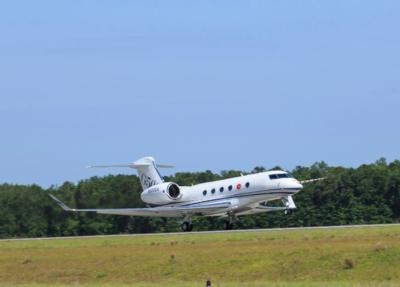Mon, May 18, 2015
Two-Hour And 16-Minute Flight Conducted For Evaluation Of Multiple Systems
There's another new business jet starting its flight test program. The all-new Gulfstream G500 successfully completed its first flight Monday.

The G500 took off at 10:39 a.m. May 18 from Savannah-Hilton Head International Airport, with Gulfstream experimental test pilots Scott Martin and Kevin Claffy at the controls. Flight Test engineer Bill Osborne provided on-board support.
The aircraft climbed to an initial altitude of 10,500 feet and reached a maximum altitude of 15,000 ft. During the 2-hour-and-16-minute flight, the crew exercised all primary flight control systems; evaluated handling qualities in takeoff and landing configurations; performed a simulated approach and go-around; and checked all systems using the Symmetry flight deck touchscreen controllers. The aircraft achieved a maximum air speed of 194 knots. It landed back in Savannah at 12:55 p.m. local time.
“The successful first flight of N500GA represents the tremendous investments we have made in the G500 program,” said Dan Nale, senior vice president, Programs, Engineering and Test, Gulfstream. “We have achieved this milestone thanks to Gulfstream’s world-class research and development teams and our commitment to setting new standards for business aviation.”
Years before this first flight, Gulfstream established four labs dedicated to the G500 program:
- A Conceptual Advanced Simulation Environment to develop fly-by-wire control laws and perform human factors evaluations
- A systems integration bench to integrate the avionics and aircraft systems with the aircraft’s Data Concentration Network
- A full flight deck integration test facility to evaluate major avionic and aircraft systems and software
- The ITF also includes an outfitted cabin to test the galley, the Gulfstream Cabin Management System and other interior elements
- And an iron bird — a spatially correct, dimensionally accurate structure, including the flight deck, used to rigorously evaluate the fly-by-wire flight controls, hydraulics, electrical systems and landing gear
- Before today’s flight, Gulfstream completed more than 34,000 hours of testing in the G500 labs on the ground before taking to the skies.
The G500 flight-test program consists of five aircraft, including a fully outfitted production aircraft that will allow the company to test all the interior elements and complete integration of the aircraft systems with the passenger experience.
The G500 is expected to receive type certification from the U.S. Federal Aviation Administration and European Aviation Safety Agency in 2017. It is slated to enter service in 2018.
(Image provided by Gulfstream)
More News
From 2023 (YouTube Version): Legacy of a Titan Robert (Bob) Anderson Hoover was a fighter pilot, test pilot, flight instructor, and air show superstar. More so, Bob Hoover was an i>[...]
Get The Latest in Aviation News NOW on Instagram Are you on Instagram yet? It's been around for a few years, quietly picking up traction mostly thanks to everybody's new obsession >[...]
Aero Linx: B-52H Stratofortress The B-52H Stratofortress is a long-range, heavy bomber that can perform a variety of missions. The bomber is capable of flying at high subsonic spee>[...]
Altimeter Setting The barometric pressure reading used to adjust a pressure altimeter for variations in existing atmospheric pressure or to the standard altimeter setting (29.92).>[...]
"Knowing that we play an active part in bettering people's lives is extremely rewarding. My team and I are very thankful for the opportunity to be here and to help in any way we ca>[...]
 Classic Aero-TV: Remembering Bob Hoover
Classic Aero-TV: Remembering Bob Hoover ANN FAQ: Follow Us On Instagram!
ANN FAQ: Follow Us On Instagram! ANN's Daily Aero-Linx (05.15.24)
ANN's Daily Aero-Linx (05.15.24) ANN's Daily Aero-Term (05.15.24):Altimeter Setting
ANN's Daily Aero-Term (05.15.24):Altimeter Setting Aero-News: Quote of the Day (05.16.24)
Aero-News: Quote of the Day (05.16.24)



